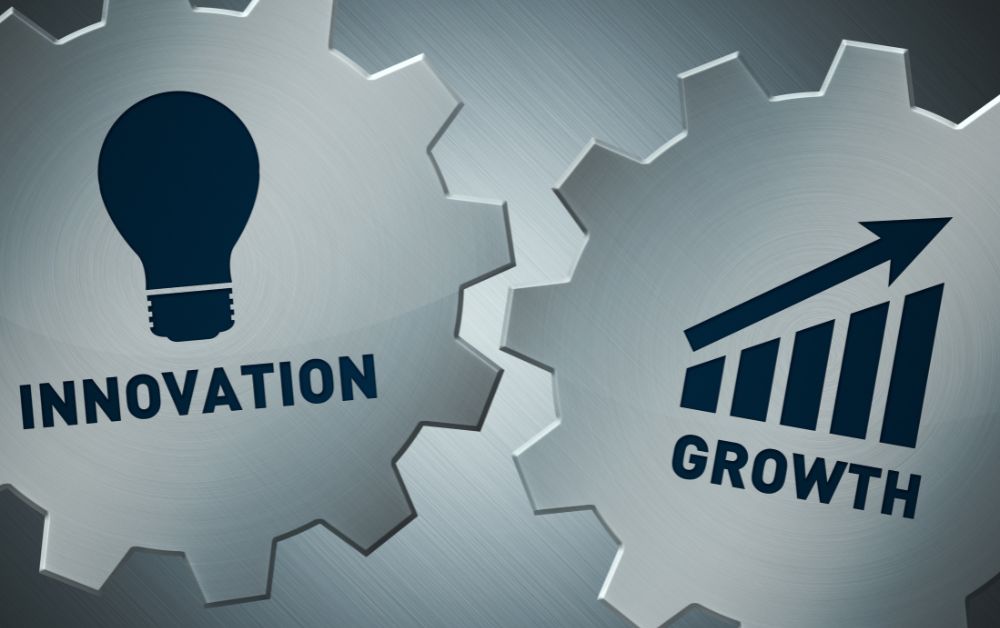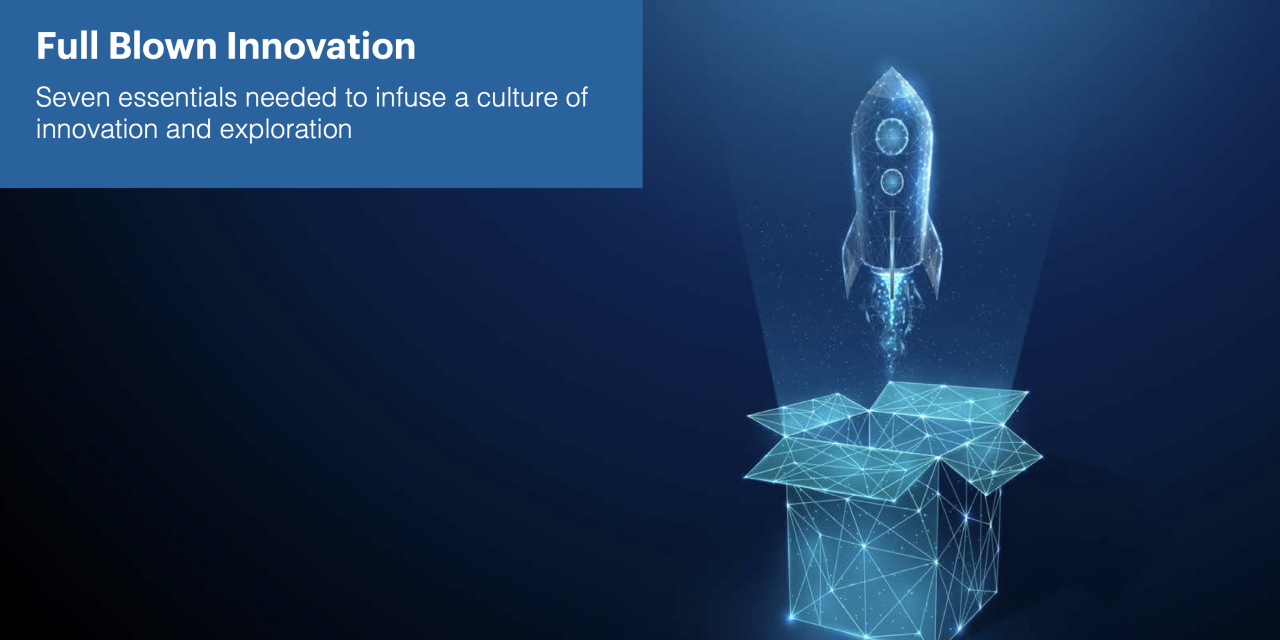Introduction: Debunking the Innovation Myth.
The notion that only nimble startups can be truly innovative is one of business’s most persistent myths. Many believe that once a company grows beyond a certain size, bureaucracy hardens, processes become rigid, and creativity gradually fades away. Our research tells a different story.
Large, innovative organisations aren’t innovative by accident. They strategically balance what we call “cool” components with essential stabilising elements. This balanced approach allows them to deliver remarkable levels of sustained innovation despite their size.
This balance is the first crucial component of our Full Blown Innovation Framework – a comprehensive approach that comprises seven essential elements for driving innovation in organisations of all sizes. In this article, we’ll explore this first component: Balancing the Business.
The Royal Princess Analogy: Size and Innovation.
To understand how large organisations maintain innovation, consider the Royal Princess cruise ship. At over a third of a kilometre long, this engineering marvel is longer than three professional football pitches laid end-to-end and taller than Nelson’s Column.
Above the waterline, passengers see the exciting amenities—pools, slides, restaurants, and entertainment venues. Below the waterline, hidden from view, are sophisticated systems that keep the ship stable: gyroscopic controls, stabilising fins, and ballast tanks that prevent the massive vessel from capsizing in rough seas.
This cruise ship perfectly illustrates innovation in large enterprises:
- Above the waterline: The visible, “cool” components that everyone associates with innovation
- Below the waterline: The stabilising components that prevent innovation from running aground
The 10 Components of Full Blown Innovation.
Our research has identified ten crucial components that must be balanced for successful innovation in large organisations:
Five “Cool” Components (Above the Waterline)
- Higher social purpose
- Tolerance for failure
- Willingness to experiment
- Psychological safety
- Organisational flatness
Five “Stabilising” Components (Below the Waterline)
- Innovating for profit and growth
- Rigorous discipline and intolerance for incompetence
- Culture of openness and candour
- Individual accountability
- Strong leadership
The magic happens when organisations integrate and balance these components rather than focusing exclusively on the visible “cool” aspects of innovation.
Why Most Innovation Efforts Fail.
When companies try to emulate the innovation cultures of tech giants like Google, Apple, or Uber, they often focus solely on the visible aspects—foosball tables, beanbags, slides, and free food. They implement these surface-level changes expecting creative ideas to flow but are disappointed when innovation doesn’t materialise.
The truth is that successful innovative organisations maintain a delicate balance between the exciting, visible components and their stabilising counterparts. Simply asking your organisation to “be more like Google” is about as realistic as asking a French poodle to sing the national anthem while playing a musical instrument.
Let’s explore how each of these components must be balanced:
A) Higher Social Purpose vs. Innovating for Profit and Growth
According to research by Havas, 85% of people expect businesses to do more than just deliver returns to shareholders. This expectation has led to the emergence of a new social contract between business and society, exemplified by Fortune magazine’s “Change the World” list featuring companies like Unilever, PayPal, and JP Morgan.
In August 2019, the Business Roundtable, comprising 181 CEOs of America’s largest companies, signed a charter committing their organisations “to lead for the benefit of all stakeholders.” Research supports this shift: purpose-driven companies attract better talent, inspire richer innovation, make faster decisions, build greater trust, and attract more investment.
Yet, despite widespread recognition of purpose’s importance, 68% of business leaders acknowledge that purpose isn’t used as a guidepost in their decision-making processes. Only 33% of employees draw real meaning from their employer’s stated purpose.
This disconnect reveals the first innovation paradox: while purpose drives innovation, profit sustains it. As Jack Welch wisely noted: “On the face of it, shareholder value is the dumbest idea in the world. Profits are the result of you doing a great job… But you’ve got to eat while you dream. You’ve got to deliver on short-range commitments, while you develop a long-range strategy and vision and implement it.”
The most innovative organisations balance aspirational purpose with practical profitability.
B) Failure and Experimentation vs. Rigorous Discipline
Innovation requires exploration of uncharted territory, making tolerance for experimentation and failure essential. As Elon Musk famously said: “Failure is an option here. If things are not failing, you are not innovating enough.”
However, truly innovative organisations pair this tolerance with a fierce intolerance for incompetence. At Tesla, Musk sets impossibly high standards—like building an electric sports car that could outpace a Ferrari from a standing start, at a time when electric vehicles were painfully slow. By hiring exceptional talent and rejecting mediocrity, while still allowing creative freedom to experiment and fail, Tesla achieved what seemed impossible.
The key distinction: productive failures that generate valuable knowledge are celebrated, while failures due to sloppiness or incompetence are not tolerated. This distinction must be clearly articulated by leadership and reinforced through organizational storytelling.
Building this balance requires:
- Clear communication of performance standards and capability expectations
- Leadership that models these expectations
- Potentially higher recruitment standards, even if growth temporarily slows
- Disciplined approaches to experimentation that maximize learning while minimizing costs
In healthcare settings like the NHS, where incompetence can cost lives, innovation is still encouraged because it leads to solutions that save more lives within constrained budgets. The focus shifts from the fear of failure to the value of learning.
C) Psychological Safety vs. Openness and Candor
Google’s two-year study of 180 teams revealed that psychological safety – an environment where people feel safe to take risks and be vulnerable—was the defining characteristic of their most successful teams.
In psychologically safe cultures, people speak truthfully about problems without fear of reprisal. This safety not only prevents catastrophic errors but supports learning and innovation. Teams with psychologically safe environments showed lower turnover, better utilization of diversity, and greater innovation.
Amy Edmondson of Harvard describes building psychological safety in three steps:
- Frame the work – Explain the purpose and why innovation matters
- Invite engagement – Encourage participation across hierarchies
- Respond productively – Demonstrate that speaking up leads to positive action
However, psychological safety must be balanced with “radical candor”—honest feedback given with good intentions. Without the ability to criticize, challenge superiors, debate ideas, and raise counterpoints, innovation suffers. The manner in which candor is delivered matters as much as the content.
D) Organisational Flatness vs. Individual Accountability
When decision-making processes lack clarity, accountability often evaporates. No individual feels responsible for delivery, and innovation stalls.
Leaders in innovative organisations publicly hold themselves accountable while demonstrating willingness to collaborate. This approach requires courage since results ultimately rest with leadership, not just teams working on innovations. However, if leaders deflect responsibility to specific employees or teams, innovation will likely be stifled.
Clear decision-making processes, pushing decisions to the lowest possible level, and transparent accountability mechanisms all help maintain this balance.
E) Flat Hierarchy vs. Strong Leadership
Culturally flat organisations – where people at all levels are expected to take action, make decisions, and voice opinions regardless of title—tend to be more agile and generate a richer diversity of ideas. Leadership in these environments is granted based on respect and competence rather than position, with leadership roles shifting from one project to the next.
However, flat organisations require stronger, not weaker, leadership. Without clear strategic priorities and direction from the top, flat structures can devolve into chaos.
Investec Private Bank exemplifies this balance. Decision-making and accountability are pushed downward, with employees at all levels exercising significant autonomy. Yet the bank features strong, visionary leaders who remain highly visible and accessible, spending considerable time communicating goals, reinforcing values, and articulating key principles.
At Investec, senior leaders maintain an open-plan office environment, have monthly meals with junior talent, and create a culture where “anyone can say what they like to anybody” with “complete access to the CEO.” This approach creates what co-founder Bernard Kantor describes as their competitive advantage: “We can’t compete on our balance sheet, but the quality of our employees is exceptional, and we’re not bogged down by hierarchies.”

Conclusion: Finding Your Balance.
Innovation in large organisations isn’t about mimicking the visible trappings of innovative companies or blindly pursuing “cool” components at the expense of stability. It’s about thoughtfully balancing these opposing forces to create an environment where creativity can flourish within a framework that ensures sustainability.
Like the Royal Princess cruise ship, your organisation needs both the exciting elements that passengers can see and the sophisticated stabilising systems below the waterline. By balancing purpose with profit, experimentation with discipline, psychological safety with candour, flatness with accountability, and hierarchy with leadership, your organisation can achieve sustained innovation regardless of its size.
Balancing the Business is just the first of seven powerful components in our Full Blown Innovation Framework. While this balance forms the foundation, the complete framework offers a comprehensive approach to building and sustaining innovation in organisations of any size.
Ready to Transform Your Organisation’s Innovation Capability?
Understanding how to balance these ten components is a crucial first step, but true innovation transformation requires a holistic approach. Our Full Blown Innovation Framework comprises seven essential components that work together to create sustainable innovation ecosystems in large organisations.
Take the Next Step
Our team offers tailored solutions to help you implement the complete Full Blown Innovation Framework:
- Executive Keynote Presentations: Inspire your leadership team with insights on all seven components of our innovation framework.
- Strategic Innovation Workshops: Work hands-on with our experts to apply the framework directly to your organisation’s unique challenges and opportunities.
To book an appointment or learn more about how the Full Blown Innovation Framework can transform your organisation, contact us here.

Key Questions for Your Organisation
To begin assessing your innovation balance, consider these questions:
- How does your organisation balance higher purpose with profit imperatives?
- Can you clearly distinguish between productive failures and incompetence?
- Do your people feel psychologically safe while still giving and receiving candid feedback?
- Are your decision-making processes clear, with accountability appropriately distributed?
- How can you develop leaders who thrive in a culturally flat organisation while providing strong direction?
By thoughtfully addressing these questions and working toward balance rather than extremes, your organisation can develop the sustainable innovation capabilities needed to thrive in today’s complex business environment – and this is just the beginning of your innovation journey.
TomorrowToday Consulting empowers forward-thinking organisations to not just anticipate the future, but to shape it. Staying ahead of the curve is critical, and we provide the visionary thinking and strategic execution you need to thrive.
We invite you to connect with Graeme Codrington and Dean van Leeuwen, two of our lead futurists, or if you would prefer, I’d be happy to schedule a meeting to connect you with them to chat about the biggest Grey Elephant you’re seeing in your industry right now.



